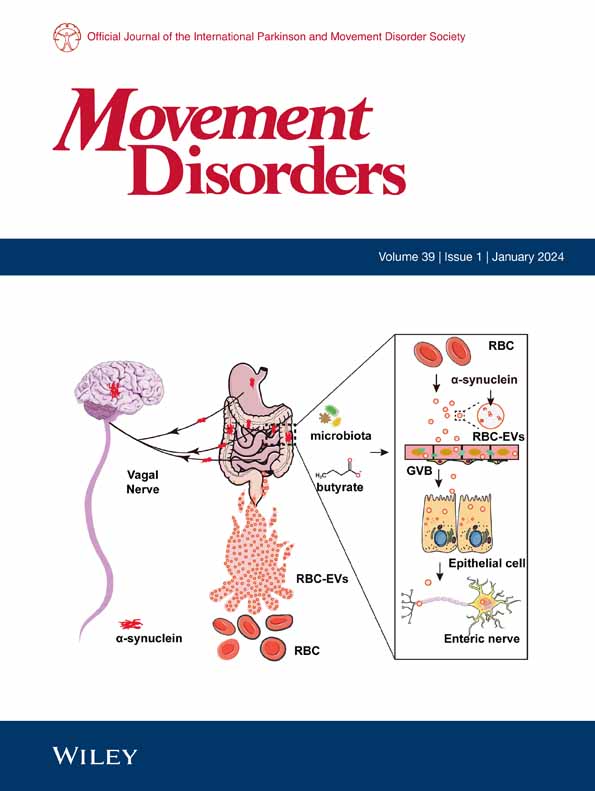婴幼儿帕金森氏症-肌张力障碍量表的开发与初步验证。
IF 7.4
1区 医学
Q1 CLINICAL NEUROLOGY
引用次数: 0
摘要
背景:婴儿期帕金森病很少见,且与肌张力障碍高度相关。在治疗和特征发育和婴儿退行性帕金森突出需要一个专门的评估量表。目的:设计并验证一种早期帕金森性肌张力障碍的有效评估量表。方法设计婴儿帕金森-肌张力障碍评定量表(IPDRS),以捕捉帕金森-肌张力障碍早期的主要临床特征。它包括28个项目,分为三个子量表:非运动症状、运动症状和运动障碍。32例运动障碍患者按照标准化方案进行评分。三名儿童运动障碍专家对拍摄的运动检查进行独立分析,以评估相互之间的可靠性。对另外20例原发性神经递质障碍患者进行评分,其中9例在基线和治疗后进行评估。进行心理测量验证。结果共对52例患者进行了IPDRS评分。平均年龄3.1岁(标准差[SD]: 2.0),平均IPDRS评分40.8分(SD: 13.17)。内部一致性分析显示,非运动症状子量表的Cronbach's α为0.21,运动症状子量表为0.84,运动障碍子量表为0.95。Kappa指数超过0.70的项目有7个。张力障碍项目与巴里-奥尔布赖特-张力障碍量表的相关系数范围为0.46至0.64。治疗后,所有IPDRS评分均发生显著变化,效应量为2.42。结论IPDRS是一种可靠有效的早期帕金森病评估工具。需要更大样本量的进一步验证研究来证实这些发现并完成验证过程。©2025作者。Wiley期刊有限责任公司代表国际帕金森和运动障碍学会出版的《运动障碍》。本文章由计算机程序翻译,如有差异,请以英文原文为准。
Development and Preliminary Validation of a Parkinsonism-Dystonia Scale for Infants and Young Children.
BACKGROUND
Parkinsonism in infancy is rare and is highly correlated with the presence of dystonia. Advances in treating and characterizing developmental and infantile degenerative parkinsonism have highlighted the need for a specialized assessment scale.
OBJECTIVE
The aim of this study was to design and validate a scale that effectively assesses parkinsonism-dystonia in early life.
METHODS
The Infantile Parkinsonism-Dystonia Rating Scale (IPDRS) was designed to capture the key clinical features of parkinsonism-dystonia in early life. It consists of 28 items across three subscales: Non-motor symptoms, Motor symptoms, and Dyskinesias. Thirty-two patients with hypokinetic movement disorder were scored following a standardized protocol. Filmed motor examinations were analyzed independently by three pediatric movement disorders specialists to evaluate interrater reliability. Twenty additional patients with primary neurotransmitter disorders were scored, and nine of them were evaluated at baseline and after treatment. Psychometric validation was conducted.
RESULTS
A total of 52 patients were scored using the IPDRS. Mean age was 3.1 years (standard deviation [SD]: 2.0), and the mean IPDRS score was 40.8 (SD: 13.17). Internal consistency analysis demonstrated a Cronbach's α of 0.21 for Non-motor symptoms subscale, 0.84 for Motor symptoms subscale, and 0.95 for Dyskinesia subscale. Kappa indexes exceeded 0.70 in seven items. Correlation coefficients for dystonia items with the Barry-Albright-Dystonia Scale ranged from 0.46 to 0.64. After treatment, all IPDRS scores changed significantly, with an effect size of 2.42.
CONCLUSIONS
The IPDRS appears to be a reliable and valid tool for assessing parkinsonism in early life. Further validation studies with a larger sample size are needed to confirm these findings and complete the validation process. © 2025 The Author(s). Movement Disorders published by Wiley Periodicals LLC on behalf of International Parkinson and Movement Disorder Society.
求助全文
通过发布文献求助,成功后即可免费获取论文全文。
去求助
来源期刊

Movement Disorders
医学-临床神经学
CiteScore
13.30
自引率
8.10%
发文量
371
审稿时长
12 months
期刊介绍:
Movement Disorders publishes a variety of content types including Reviews, Viewpoints, Full Length Articles, Historical Reports, Brief Reports, and Letters. The journal considers original manuscripts on topics related to the diagnosis, therapeutics, pharmacology, biochemistry, physiology, etiology, genetics, and epidemiology of movement disorders. Appropriate topics include Parkinsonism, Chorea, Tremors, Dystonia, Myoclonus, Tics, Tardive Dyskinesia, Spasticity, and Ataxia.
 求助内容:
求助内容: 应助结果提醒方式:
应助结果提醒方式:


